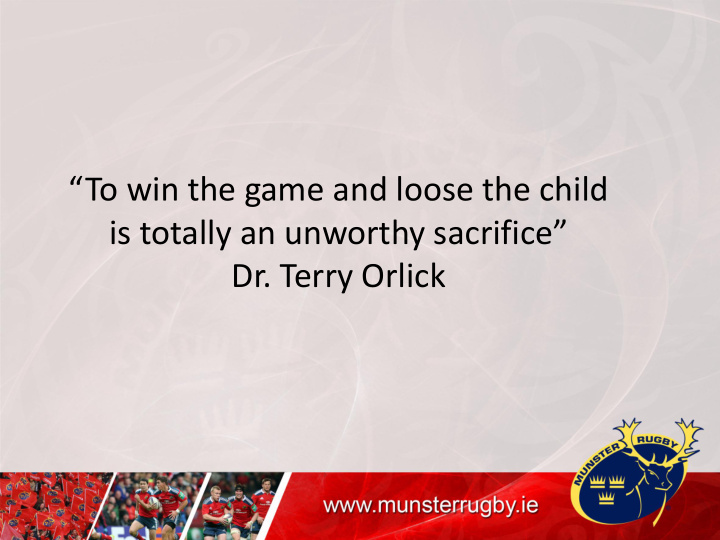



“To win the game and loose the child is totally an unworthy sacrifice” Dr. Terry Orlick
Training the Age Grade Athlete FEARGAL O’CALLAGHAN HEAD OF AGE GRADE STRENGTH & CONDITIONING AND COACH EDUCATION
Training the Age Grade Athlete http://www.youtube.com/watch?v=7NZ6 C6wGpAE https://youtu.be/x9WCjmo6V1A https://youtu.be/1FA8-oKidgo?t=71 https://youtu.be/ZLmcUJoURWk
The WHO
Munster Professional Team Academy Sub-Academy U20 U19 U18 Schools U18 Clubs “A” Schools Clubs
The WHAT
For those who want to take part in organised and/or competitive sport, appropriate physical conditioning which includes strength training and FMS development will help reduce the potential for athletic injuries and form the foundation for more advanced training modes
Training the Age Grade Athlete The key purpose of coaching is to interact Our Goal As Coaches? with participants in a manner which Maximize the Development of Players How do we view Sport? enhances their learning. In other words, Development is Multidisciplinary that thanks to us being there, they learn biological, social, psychological etc.. more, faster and in longer lasting ways than Positive Youth Development they would when left to their own devices. Children are resources to be developed not problems to be managed
Physical Literacy - FMS Sports Specific Skills • Enjoyment is the main rugby, football, hurling etc… priority • The broader the range of Fundamental Sports Skills skills the greater the chance evasion, striking and fielding of reaching full potential and lifelong participation • Children with high levels of Fundamentals Movement Skills run, jump, hop, catch, kick, skip, throw etc…. physical literacy pick up sports specific skills easier FUNdamentals of movement balance, coordination and agility
Fundamental Movement Skills • Provide the basic building blocks • Typically considered from birth to 12 years old • Studies have shown improvements can be made at all ages • Movement skills to be continually reinforces • Research does support systematic fundamental movement and sports skills development in children • Should be developed to prevent a proficiency barrier
Adolescents who do not develop training age in younger years will have more difficulty mastering FMS in their post pubertal and teenage years
What are we looking for the young players to be able to do? • Good squat patterns – with variety • Good landing mechanics – single and double • Good running mechanics – skipping and marching, acceleration and deceleration • Good general movement/flexibility
The HOW https://www.youtube.com/watch?v=tl_gzZZsp G4
Traditional Youth Development Coaches Focused On Technical Physical Tactical
Traditional Youth Development Coaches Neglected Mental Social & Personal
Would This Not Be Better
Training the Age Grade Athlete The Coaching Cycle: K-WEAR Sergio Lara-Bercial (2012) Watch Know Evaluate Reflect Act
Training the Age Grade Athlete The Coaching Zones Sergio Lara-Bercial (2012)
Training the Age Grade Athlete SPECC Model Sergio Lara-Bercial (2012) • Social Beam • Physical Beam All session/activities should contain elements that challenge in the four • beams Emotional Beam • Cognitive Beam
Training the Age Grade Athlete STEP Model Changes to the size of the playing area, distance to be covered or the size S pace of a target Changes to the actual task itself. Changing from running to skipping, T ask from kicking to throwing Changes to the implements that are being used for the activity. E quipment Bigger/Smaller size or weight Change the number of people involved in the activity. More attackers to P eople defenders
“To win the game and loose the child is totally an unworthy sacrifice” Dr. Terry Orlick
Recommend
More recommend